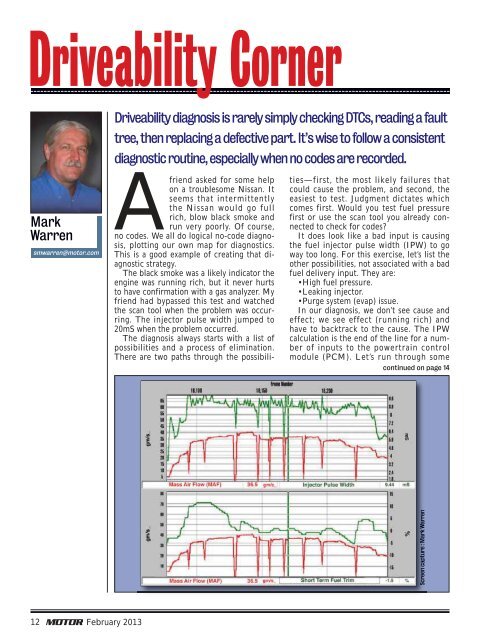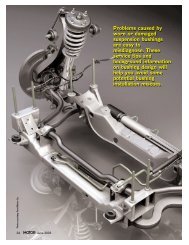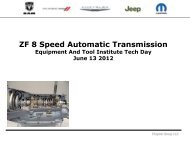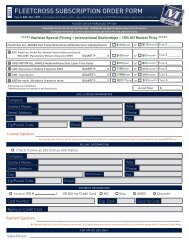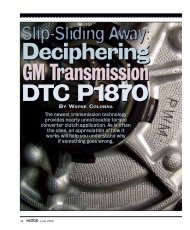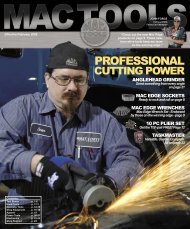Driveability Corner - MOTOR Information Systems
Driveability Corner - MOTOR Information Systems
Driveability Corner - MOTOR Information Systems
Create successful ePaper yourself
Turn your PDF publications into a flip-book with our unique Google optimized e-Paper software.
<strong>Driveability</strong> <strong>Corner</strong><br />
<strong>Driveability</strong> diagnosis is rarely simply checking DTCs, reading a fault<br />
tree, then replacing a defective part. It’s wise to follow a consistent<br />
diagnostic routine, especially when no codes are recorded.<br />
Mark<br />
Warren<br />
smwarren@motor.com<br />
Afriend asked for some help<br />
on a troublesome Nissan. It<br />
seems that intermittently<br />
the Nissan would go full<br />
rich, blow black smoke and<br />
run very poorly. Of course,<br />
no codes. We all do logical no-code diagnosis,<br />
plotting our own map for diagnostics.<br />
This is a good example of creating that diagnostic<br />
strategy.<br />
The black smoke was a likely indicator the<br />
engine was running rich, but it never hurts<br />
to have confirmation with a gas analyzer. My<br />
friend had bypassed this test and watched<br />
the scan tool when the problem was occurring.<br />
The injector pulse width jumped to<br />
20mS when the problem occurred.<br />
The diagnosis always starts with a list of<br />
possibilities and a process of elimination.<br />
There are two paths through the possibilities—first,<br />
the most likely failures that<br />
could cause the problem, and second, the<br />
easiest to test. Judgment dictates which<br />
comes first. Would you test fuel pressure<br />
first or use the scan tool you already connected<br />
to check for codes?<br />
It does look like a bad input is causing<br />
the fuel injector pulse width (IPW) to go<br />
way too long. For this exercise, let’s list the<br />
other possibilities, not associated with a bad<br />
fuel delivery input. They are:<br />
•High fuel pressure.<br />
•Leaking injector.<br />
•Purge system (evap) issue.<br />
In our diagnosis, we don’t see cause and<br />
effect; we see effect (running rich) and<br />
have to backtrack to the cause. The IPW<br />
calculation is the end of the line for a number<br />
of inputs to the powertrain control<br />
module (PCM). Let’s run through some<br />
continued on page 14<br />
Screen capture : Mark Warren<br />
12 February 2013
<strong>Driveability</strong> <strong>Corner</strong><br />
possible defective inputs that would<br />
cause this problem:<br />
Mass Airflow (MAF) Sensor. In<br />
the scan capture of a defective<br />
MAF signal shown on page 12, note<br />
the dropouts in the MAF signal<br />
(green in the top graph), the corresponding<br />
drops in IPW (red) and<br />
the drop in short-term fuel trim<br />
(red, in the lower graph).<br />
In this example, of course, the<br />
drop caused a lean condition, which<br />
is more common than a rich condition<br />
on this Nissan. Our Nissan’s<br />
MAF signal was perfect when the<br />
defect occurred.<br />
Oxygen Sensors. Next, did the<br />
O 2 sensors respond correctly when<br />
the problem was not occurring and<br />
when it occurred? According to the<br />
information provided to me, they<br />
ranged correctly in response to a<br />
snap throttle test when the problem<br />
was not occurring and stuck rich<br />
when the Nissan ran rich. Don’t<br />
forget to test the postcatalyst O 2<br />
sensor; generally, the trim authority<br />
for the rear O 2 sensor is limited and<br />
cannot create such a dramatic rich<br />
condition. But on some vehicles,<br />
the rear O 2 sensor has unlimited authority<br />
and can cause a stuck-rich or<br />
stuck-lean condition.<br />
Temperature Sensor. Start disconnecting<br />
temperature sensors on<br />
late-model vehicles and you’ll note<br />
that when running, the temp sensor<br />
generally has no effect on determining<br />
fuel delivery. This is unlike<br />
the early days when the temp sensor<br />
had unlimited authority and an<br />
open sensor would cause a stuckrich<br />
condition.<br />
Throttle Position Sensor. A<br />
wide-open throttle command may<br />
cause a rich condition, but this is<br />
pretty unlikely. On a throttle-bywire<br />
system, the system is moni-<br />
tored very closely for safety reasons<br />
and will always set a code. Also, the<br />
redundancy in the system would<br />
never allow this rich condition to<br />
occur.<br />
Crank and Cam Sensors. The<br />
crank and cam sensors time and sync<br />
the injector signal. Corrupted signals<br />
can cause double-injection events or<br />
other strange behavior. An oscilloscope<br />
is mandatory here, but any<br />
aberration in a tach or rpm input<br />
may signal a problem in this area.<br />
Power and Grounds. These<br />
guys can never be left out of almost<br />
any no-code diagnosis. The effect of<br />
bad power or grounds can be wideranging<br />
and extreme. After seven<br />
years or 70,000 miles of vehicle use,<br />
issues in this area become more<br />
common.<br />
Crank Signal. I know of a similar<br />
intermittent running-rich case<br />
where the PCM received an inter-<br />
Circle #13<br />
14 February 2013
mittent crank signal while running.<br />
During crank, generally the PCM<br />
commands extra fuel for starting.<br />
The crank signal wire from the<br />
starter on this vehicle was intermittently<br />
shorting to 12 volts, signaling<br />
the computer that cranking/starting<br />
was occurring. The computer obviously<br />
did not have a rationality test<br />
to compare the crank signal to current<br />
rpm and commanded fuel enrichment.<br />
This is one of those crazy problems<br />
right out of left field. Using an<br />
eight-trace scope to monitor many<br />
signals and extreme persistence<br />
fixed this problem. The advantage<br />
of the eight-trace scope is for monitoring<br />
and eliminating the most<br />
likely possibilities during the intermittent<br />
event.<br />
Vehicle Speed Sensor. I had a<br />
computer-controlled Honda many<br />
years ago that gave me fits over a<br />
pig-rich condition. The O 2 sensors<br />
worked fine. When I restricted fuel<br />
they went lean, and they correctly<br />
indicated rich when the Honda ran<br />
rich. I could turn in the idle mixture<br />
screw and watch the gas analyzer<br />
go lean and then watch as the<br />
system commanded it back rich.<br />
The system was commanding this<br />
vehicle rich. The question was:<br />
Why? The customer request was to<br />
fix the emissions problem and, after<br />
the cost was known, look at the<br />
speedometer and estimate the cost<br />
to repair it as well. After two days of<br />
no luck with the fueling problem, I<br />
decided to look at the speedometer<br />
issue just to have some repair success<br />
with this vehicle. The vehicle<br />
speed sensor (VSS) on the back of<br />
the transmission was bad and cost<br />
about 25 bucks. I fixed the speedo<br />
and took the vehicle for a test drive<br />
to confirm the repair. Lo and behold,<br />
the fueling problem was fixed!<br />
It turns out this Honda had a catalytic<br />
converter strategy that drove<br />
the system rich if the vehicle remained<br />
stationary (no VSS signal)<br />
for more than two minutes with the<br />
engine running. It seems these vehicles<br />
had a problem with the converters<br />
getting hot at idle and burning<br />
the carpet in the vehicle. After<br />
sitting and not moving, with no<br />
VSS, the system went rich to cool<br />
and unlight the catalytic converter.<br />
With a failed VSS, the system was<br />
stuck in this mode.<br />
There was a code set for the VSS.<br />
Even if a code seems logically unrelated<br />
to your problem, take a hard<br />
look at that component and consider<br />
making the fix.<br />
Remember, a logical diagnostic<br />
procedure, thinking out of the box<br />
and a good dose of luck never hurt<br />
in the diagnostic hunt.<br />
Circle #14<br />
February 2013<br />
15


